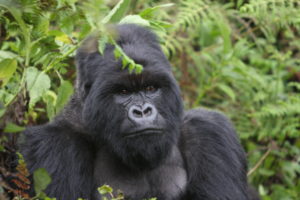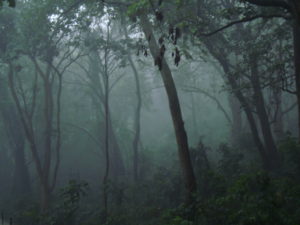Dian Fossey, the world’s leading expert on mountain gorillas, was born on January 16, 1932 (died 1985). She followed her dream to visit Africa as a young woman. There she discovered an affinity to nature and specifically to mountain gorillas that occupied her entire life and led to her murder in a machete attack in the remote Rwandan wilderness. Her life was immortalized in the feature film, “Gorillas in the Mist,” starring Sigourney Weaver.
Fossey grew up in San Francisco. She was always interested in animals, but did not pursue a career related to them. Instead, she became an occupational therapist, first in California and later in Louisville, Kentucky. When a friend returned from an African safari filled with stories of the animals and excitement she had experienced, Fossey decided she needed to take a similar trip herself, then, before she grew too old. So, at age 31, she cashed in her life savings, took out a bank loan and headed to Africa.

The trip changed Fossey’s life. She met the famous paleontologist Louis Leakey at his camp in Olduvai Gorge. Leakey told her that in order to understand human behavior, we needed to study our closest relatives—the great apes. Leakey had begun funding Jane Goodall’s studies of chimpanzees a few years earlier, and he encouraged a similar study of mountain gorillas (learn more about Goodall here). Later on the tour, Fossey saw her first mountain gorillas, and her fate was determined. “I believe it was at this time,” she wrote, “the seed was planted in my head, even if unconsciously, that I would someday return to Africa to study the gorillas of the mountains.”
Louis Leakey came to Louisville a few years later to lecture, and Fossey renewed their acquaintance. Leakey invited her to come to Africa to study gorillas, but insisted that she first have her appendix removed to avoid any problems in the field. She did so—to Leakey’s surprise, because he claimed this was just his way to test the sincerity of a person’s interest, not intending for anyone to follow through on the idea. Leakey was obviously impressed and after securing funding, brought Fossey back to Africa in 1966.

She initially set up an observation camp in the Congo, in the Virunga Mountains that are now the only known home of the mountain gorilla. Fossey spent all her time in the field, watching gorillas and gradually gaining their trust. In a short time, the animals became habituated to Fossey’s presence so that she could observe them continuously at close range. She learned to identify individuals from three distinct groups. From her copious notes, she wrote several articles about the gorillas’ behavior. He work attracted the attention of National Geographic Magazine, and she appeared on the magazine’s cover—her work and her concern for the conservation of the gorillas was now part of the global consciousness (learn more about the National Geographic Society here).
When civil war made the Congo too dangerous, she moved to neighboring Rwanda. There she set up a new camp—Karisoke—that became her field home for the rest of her life. She always felt that her lack of scientific training inhibited her work and the acceptance of it by the scientific community. So, she began graduate study at Cambridge University, receiving a doctorate in animal behavior in 1974.
But it was her fierce commitment to protecting the mountain gorilla that drove Fossey. She had a reputation as a difficult personality to begin with, not helped by her alleged heavy drinking. But when gorilla poaching was the problem, she was ferocious. She adopted voodoo-like techniques to make locals believe she had special evil powers, often pursued and captured poachers and claimed to torture them. She clashed with other conservationists who promoted education as the long-term solution to poaching, preferring to take the battle directly to any poacher she confronted.
Her attacks on poaching and poachers probably led to her death. She was discovered murdered in her mountain cabin on December 27, 1985, victim of a vicious machete ambush. The murder has never been solved, and views differ on who the culprit or culprits might have been—poachers, smugglers, or even some of her own staff. She is buried at her field station, beside a beloved mountain gorilla, Digit, that was killed by poachers a few years earlier.
Fossey believed that the mountain gorilla was unlikely to survive, but the reality is that their numbers continue to climb today, albeit slowly. Dian Fossey taught the world that the mountain gorilla was not an evil monster, but rather a gentle, shy, loving creature. The publicity that she brought to their understanding and conservation has begun to do its work. Probably because of her efforts, the mountain gorilla looks today like a survivor, not a casualty.
References:
Dian fossey Gorilla Fund International. Dian Fossey Biography. Available at: https://gorillafund.org/who-we-are/dian-fossey/dian-fossey-bio/. Accessed January 15, 2017.
Hogenboom, Melissa. 2015. The woman who gave her life to save the gorillas. BBC Earth, December 26, 2015. Available at: http://www.bbc.com/earth/story/20151226-the-woman-who-gave-her-life-to-save-the-gorillas. Accessed January 15, 2017.
